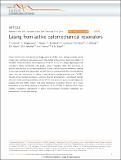Lasing from active optomechanical resonators
Abstract
Planar microcavities with distributed Bragg reflectors (DBRs) host, besides confined optical modes, also mechanical resonances due to stop bands in the phonon dispersion relation of the DBRs. These resonances have frequencies in the 10- to 100-GHz range, depending on the resonatorâ optical wavelength, with quality factors exceeding 1,000. The interaction of photons and phonons in such optomechanical systems can be drastically enhanced, opening a new route towards the manipulation of light. Here we implemented active semiconducting layers into the microcavity to obtain a vertical-cavity surface-emitting laser (VCSEL). Thereby, three resonant excitations - photons, phonons and electrons - can interact strongly with each other providing modulation of the VCSEL laser emission: a picosecond strain pulse injected into the VCSEL excites long-living mechanical resonances therein. As a result, modulation of the lasing intensity at frequencies up to 40â €‰GHz is observed. From these findings, prospective applications of active optomechanical resonators integrated into nanophotonic circuits may emerge.
Citation
Czerniuk , T , Brüggemann , C , Tepper , J , Brodbeck , S , Schneider , C , Kamp , M , Höfling , S , Glavin , B A , Yakovlev , D R , Akimov , A V & Bayer , M 2014 , ' Lasing from active optomechanical resonators ' , Nature Communications , vol. 5 , 4038 . https://doi.org/10.1038/ncomms5038
Publication
Nature Communications
Status
Peer reviewed
ISSN
2041-1723Type
Journal article
Description
This study was funded by the Deutsche Forschungsgemeinschaft (project BA 1549/14-1), the State of Bavaria and the Ukrainian State Fund for Fundamental Researches (programme SFFR-DFG). A.V.A. also acknowledges financial support by the Alexander von Humboldt Foundation. M.B. acknowledges partial financial support from the Russian Ministry of Science and Education (contract No.14.Z50.31.0021).Collections
Items in the St Andrews Research Repository are protected by copyright, with all rights reserved, unless otherwise indicated.

